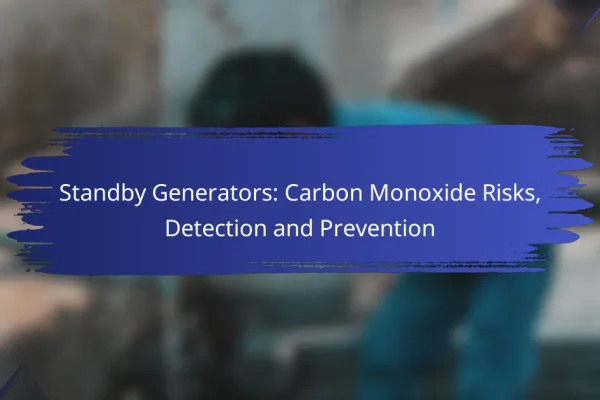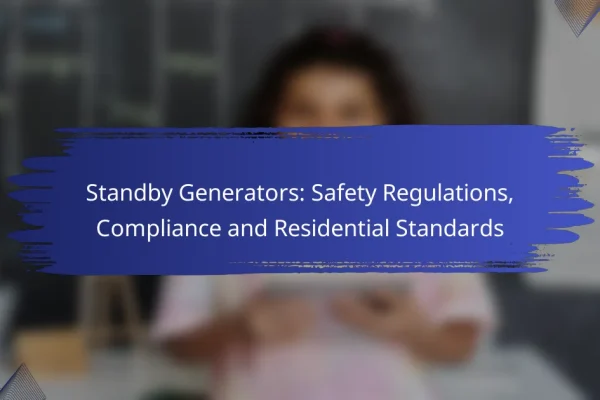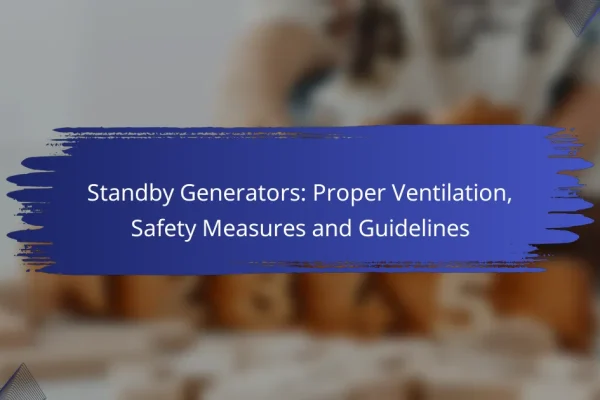What are the safety measures for standby generators?
Safety measures for standby generators include regular maintenance, proper installation, and adherence to safety regulations. These precautions help prevent accidents and ensure the generator operates efficiently during power outages.
Regular maintenance checks
Regular maintenance checks are crucial for the safe operation of standby generators. Schedule inspections at least once a year to ensure all components are functioning correctly and to identify potential issues before they become serious problems.
During maintenance, check the oil levels, fuel quality, and battery condition. Replace any worn parts and clean filters to maintain optimal performance.
Installation of carbon monoxide detectors
Installing carbon monoxide detectors near the generator location is essential for safety. These detectors alert you to dangerous levels of carbon monoxide, which can be produced during generator operation.
Choose detectors that meet local safety standards and test them monthly to ensure they are functioning properly. Replace batteries as needed and follow the manufacturer’s instructions for placement.
Proper ventilation requirements
Proper ventilation is vital to prevent the buildup of harmful gases when using standby generators. Ensure that the generator is installed in a well-ventilated area, away from windows and doors.
Follow local building codes regarding ventilation and exhaust systems. If the generator is housed in a shed or garage, consider installing vents to allow fresh air circulation and exhaust gas escape.
Use of transfer switches
Using transfer switches is a critical safety measure when connecting a standby generator to your home’s electrical system. Transfer switches prevent backfeeding into the grid, which can pose risks to utility workers and damage the generator.
Install a manual or automatic transfer switch that complies with local electrical codes. This device allows for a safe and seamless transition between utility power and generator power.
Grounding and bonding practices
Proper grounding and bonding practices are essential for the safe operation of standby generators. Grounding helps prevent electrical shock and ensures the generator operates safely during power outages.
Consult local electrical codes for grounding requirements and ensure that the generator is connected to a grounding electrode system. Regularly inspect grounding connections to maintain their integrity and effectiveness.
How to choose a safe standby generator?
Choosing a safe standby generator involves assessing its design, features, and compliance with safety standards. Prioritize models that offer reliable performance, low emissions, and necessary safety certifications to ensure safe operation during power outages.
Consider noise levels
Noise levels are a crucial factor when selecting a standby generator, especially for residential areas. Look for generators with noise ratings below 60 decibels, as these are generally quieter and less disruptive. Some models feature sound-dampening technology, which can further reduce operational noise.
Additionally, consider the generator’s placement. Installing it at a distance from living spaces can help mitigate noise concerns. Always check local regulations regarding noise restrictions to ensure compliance.
Evaluate fuel type options
Standby generators typically run on natural gas, propane, or diesel. Natural gas is often preferred for its convenience and lower emissions, while propane offers portability and longer storage life. Diesel generators are known for their durability and efficiency but may produce higher emissions.
Consider your fuel availability and costs in your area. For example, if natural gas is readily accessible and economical, it may be the best choice. Always factor in the generator’s fuel consumption rate to estimate operational costs effectively.
Check for safety certifications
Safety certifications ensure that a standby generator meets industry standards for performance and safety. Look for certifications from recognized organizations such as Underwriters Laboratories (UL) or the American National Standards Institute (ANSI). These certifications indicate that the generator has undergone rigorous testing.
Additionally, verify that the generator complies with local regulations, which may include emissions standards or installation requirements. Choosing a certified generator not only enhances safety but can also be a requirement for insurance coverage in some regions.
What are the risks associated with standby generators?
Standby generators pose several risks that users must be aware of, including carbon monoxide poisoning, fire hazards, and electrical shock risks. Understanding these dangers is crucial for safe operation and maintenance.
Carbon monoxide poisoning
Carbon monoxide (CO) poisoning is a significant risk when using standby generators, especially if they are operated indoors or in poorly ventilated areas. CO is a colorless, odorless gas that can quickly accumulate and lead to serious health issues or even death.
To mitigate this risk, always place generators outdoors, at least 20 feet away from windows, doors, and vents. Installing CO detectors in your home can provide an additional layer of safety, alerting you to dangerous levels of this gas.
Fire hazards
Fire hazards are another critical concern with standby generators. Fuel leaks or improper storage of gasoline can lead to flammable situations, especially if the generator is placed near combustible materials.
To reduce fire risks, ensure that fuel is stored in approved containers and away from heat sources. Regularly inspect the generator for leaks and maintain a clear area around it to prevent any fire-related incidents.
Electrical shock risks
Electrical shock is a potential danger when operating standby generators, particularly if they are not properly grounded or if there is a malfunction. Wet conditions can further increase the risk of shock.
To prevent electrical shock, always use a ground fault circuit interrupter (GFCI) when connecting your generator to electrical systems. Avoid using the generator in wet conditions and ensure all connections are secure and insulated.
What are the local regulations for standby generators?
Local regulations for standby generators vary significantly by region, focusing on safety, installation, and environmental impact. Understanding these regulations is crucial for compliance and ensuring safe operation.
Permitting requirements in California
In California, obtaining a permit for a standby generator is typically required, especially for units over a certain capacity, often around 10 kW. Homeowners must submit plans to their local building department, which will review them for compliance with state and local codes.
Additionally, California has specific guidelines regarding emissions, so generators must meet stringent air quality standards set by the California Air Resources Board (CARB). It’s advisable to check with local authorities to ensure all requirements are met before installation.
Noise ordinances in New York
New York City has strict noise ordinances that regulate the sound levels of standby generators. Generally, generators must not exceed 45 decibels during the night and 55 decibels during the day in residential areas. This means selecting a quieter model or installing soundproofing measures may be necessary.
Homeowners should also consider the generator’s placement, as proximity to neighboring properties can affect compliance with noise regulations. Consulting with local officials can provide clarity on specific requirements and acceptable noise levels.
Installation codes in Texas
In Texas, installation codes for standby generators are governed by the National Electrical Code (NEC) and local amendments. Most installations require a licensed electrician to ensure compliance with safety standards and proper connections to the electrical system.
Homeowners should also be aware of any local zoning laws that may impact where a generator can be installed. It’s beneficial to check with local building authorities to confirm that all installation practices align with state and local regulations.
How to properly install a standby generator?
Proper installation of a standby generator is crucial for safety and efficiency. Key steps include hiring professionals, adhering to manufacturer instructions, and ensuring compliance with local regulations.
Hire a licensed electrician
Engaging a licensed electrician is essential for installing a standby generator safely. They possess the expertise to handle electrical connections and ensure that the generator operates correctly and efficiently.
Additionally, a licensed electrician can help you navigate any potential issues that may arise during installation, such as load calculations and proper wiring. This reduces the risk of electrical hazards and ensures compliance with safety standards.
Follow manufacturer guidelines
Manufacturer guidelines provide specific instructions for the installation and operation of your standby generator. Following these guidelines ensures that the generator functions as intended and maintains warranty coverage.
Key aspects to consider include placement, fuel type, and electrical connections. For example, some generators require a minimum distance from structures or vegetation to prevent fire hazards.
Ensure compliance with local codes
Compliance with local codes is vital when installing a standby generator. These codes may dictate installation practices, safety measures, and environmental considerations.
Check with local authorities or building departments to understand the specific regulations in your area. This may include permits, inspections, and adherence to zoning laws, which can vary significantly from one location to another.
What are the maintenance tips for standby generators?
Regular maintenance is crucial for standby generators to ensure reliability and longevity. Key maintenance tips include routine inspections, oil changes, and battery checks to prevent unexpected failures during power outages.
Regular Inspections
Conducting regular inspections of your standby generator is essential. Check for any signs of wear, leaks, or corrosion, and ensure that all connections are secure. Aim for inspections at least twice a year, ideally before and after the peak usage seasons.
Oil Changes
Changing the oil in your standby generator is a critical maintenance task. Depending on usage, oil should typically be changed every 100 to 150 hours of operation or at least once a year. Use the manufacturer-recommended oil type to maintain optimal performance.
Battery Maintenance
Battery health is vital for the functionality of standby generators. Check the battery terminals for corrosion and ensure that connections are tight. Batteries should be tested annually and replaced every 3 to 5 years, depending on the type and usage conditions.
Fuel System Checks
Inspect the fuel system regularly to prevent issues related to fuel quality. Ensure that fuel is fresh and free from contaminants. For gasoline generators, consider using fuel stabilizers if the generator will not be used for extended periods.
Exercise the Generator
Regularly exercising your standby generator helps keep it in good working condition. Run the generator for about 30 minutes every month under load to ensure all components function properly. This practice helps identify potential issues before they become serious problems.












